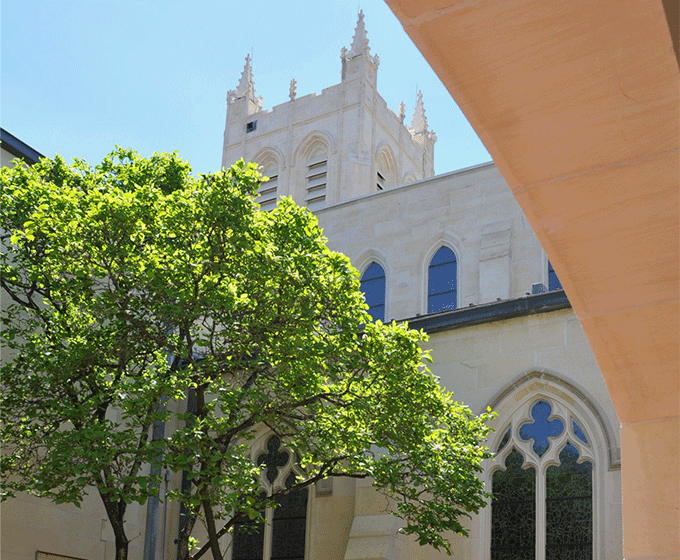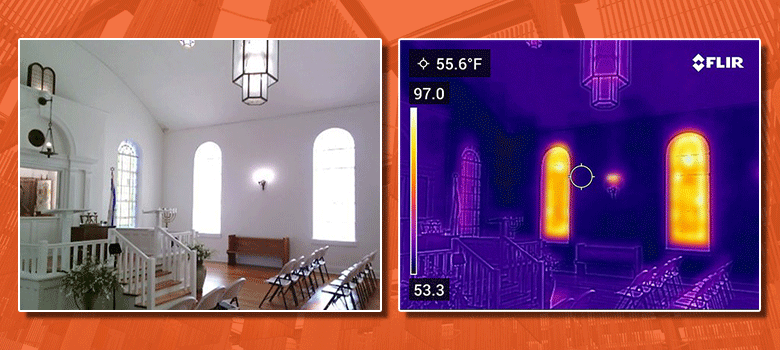
Trinity Episcopal in Houston is one nine historic houses of worship UTSA’s Center for Cultural Sustainability is helping protect from future hurricanes.
OCTOBER 26, 2021 — As the 2021 hurricane season enters its final weeks, UTSA is working with Houston-area faith leaders to protect historical buildings in their communities from damaging hurricanes.
The Resilience Roadmap is a project led by UTSA’s Center for Cultural Sustainability in conjunction with the Texas Historical Commission. It’s sponsored by a grant from the National Park Service’s Hurricanes Harvey, Irma, and Maria Emergency Supplemental Historic Preservation Fund.
The nine buildings in the program are historic houses of worship in Galveston, Harris and Victoria counties damaged by Hurricane Harvey in 2017.
They are certified eligible for the program by the National Register. The properties are also identified as sacred places for their service to the community beyond religious needs.

K’nesseth Israel Synagogue in Baytown is part of the Resilience Roadmap project. An infrared camera reveals heat penetration from windows and walls damaged by the weather.
“Historically, these places do a lot of social services. They're involved in a lot of different types of activities in their communities that have significant social and economic impact,” said William Dupont, Conservation Society of San Antonio Endowed Professor and director of UTSA’s Center for Cultural Sustainability. “We saw them as a necessity in communities preparing for—and then recovering from—hurricanes. And we also saw them as sacred places for the potential opportunity to help educate people and help whole communities prepare to withstand the multiple effects of a hurricane.”
A team of architects, engineers, and preservationists from UTSA, Eastern Michigan University, Wentworth Institute of Technology and Istanbul Technical University, along with the nonprofit Partners for Sacred Places, collaborated on the project. The action plan includes creating an assessment called a Resilience Performance Indicator or RPI. It’s a specifically designed numeric scoring system to help the keepers of these historic properties fortify their structures against hurricane damage.
“They can use the RPI as a guide, to know what to do, understand their property’s vulnerabilities and what they need to address,” Dupont said. “We picked this target audience, the faith-based organizations, because of the role that they already play in communities. The RPI can also be useful to demonstrate the need for grant writing and fundraising to make necessary repairs.”
The UTSA team developed the RPI after a six-month data collection process that involved making field visits to each of the nine locations. Using their collective expertise, they carefully examined each building and made notes of any issues such as cracks or leaky roofs. The team used a thermal camera to measure heat from the walls and collected and analyzed soil samples. A finite element analysis took place using software to gauge how well each building would perform in high winds and/or extensive flooding.
A final step involved establishing what the research team refers to as Knowledge Cafés, a series of focus groups to help uncover the many ways houses of worship contribute to disaster relief and recovery efforts. These buildings and their congregations provide emergency shelter, distribute food and supplies, host medical services, and lead volunteer teams to clean up and clear out damage from storms.
“It is not hyperbolic to say that the Texas Gulf Coast, or any area hit by a natural disaster, cannot recover without the faith community and their buildings,” said Sarah Jones, associate director of community engagement for Partners for Sacred Places.
The vital but often unrecognized role that sacred places play in disaster recovery efforts makes the preservation of these buildings a key strategy for resilience and emergency management.
“For disaster recovery, the federal government often deals in massively big programs and it's very hard for them to get down to the individual building level. Our research looks at the grassroots, asking how individuals in the fine grain of their communities are suffering through, surviving, and recovering from the disaster?” Dupont added. “What resources do they rely upon? How can we enhance those resources? How do we give direct support where it's really going to make an impact? What's surprising is nobody's paying sufficient attention at the grassroots level to that type of impact.”
The Resilience Roadmap project offers unique research experience for UTSA graduate students interested in historic preservation. Kelsey Brown is a graduate assistant on the project. She’s working toward her master’s in architecture, along with a Certificate in Historic Preservation. Brown collected data through the site assessments and assisted in other research areas. She gained valuable field awareness of structural vulnerabilities historic buildings face on the Texas Gulf Coast.
“It's really rewarding to have an opportunity to help because these places are so important to their communities in many ways,” Brown said. “It's gratifying to help these sacred places have a well-researched plan to protect and recover quickly when disaster strikes. My appreciation for historic preservation has grown through being involved with the Resilience Roadmap.”
In addition to Brown and Dupont, project team members include associate professors Angela Lombardi, Saadet Beeson and Jie Huang; assistant professor Sandeep Langar; Sedef Doganer with the Wentworth Institute of Technology; Heritage Resilience Fellow Anthony Vannette; and Tracie Quinn, marketing associate for the Center for Cultural Sustainability.
The 2021 hurricane season is relatively uneventful compared to previous years. Thanks to the efforts of the UTSA Center for Sustainability, nine historic and sacred community places on the Texas Gulf Coast will soon have a roadmap to prepare and recover from future hurricanes. A final report on the project is due in early 2022.
“Our end goal is to expand the research to other houses of worship, across all faith traditions, with a focus on equity and social justice,” Dupont said.
UTSA Today is produced by University Communications and Marketing, the official news source of The University of Texas at San Antonio. Send your feedback to news@utsa.edu. Keep up-to-date on UTSA news by visiting UTSA Today. Connect with UTSA online at Facebook, Twitter, Youtube and Instagram.
Move In To COLFA is strongly recommended for new students in COLFA. It gives you the chance to learn about the Student Success Center, campus resources and meet new friends!
Academic Classroom: Lecture Hall (MH 2.01.10,) McKinney Humanities BldgWe invite you to join us for Birds Up! Downtown, an exciting welcome back event designed to connect students with the different departments at the Downtown Campus. Students will have the opportunity to learn about some of the departments on campus, gain access to different resources, and collect some giveaways!
Bill Miller PlazaCome and celebrate this year's homecoming at the Downtown Campus with food, games, giveaways, music, and more. We look forward to seeing your Roadrunner Spirit!
Bill Miller PlazaThe University of Texas at San Antonio is dedicated to the advancement of knowledge through research and discovery, teaching and learning, community engagement and public service. As an institution of access and excellence, UTSA embraces multicultural traditions and serves as a center for intellectual and creative resources as well as a catalyst for socioeconomic development and the commercialization of intellectual property - for Texas, the nation and the world.
To be a premier public research university, providing access to educational excellence and preparing citizen leaders for the global environment.
We encourage an environment of dialogue and discovery, where integrity, excellence, respect, collaboration and innovation are fostered.